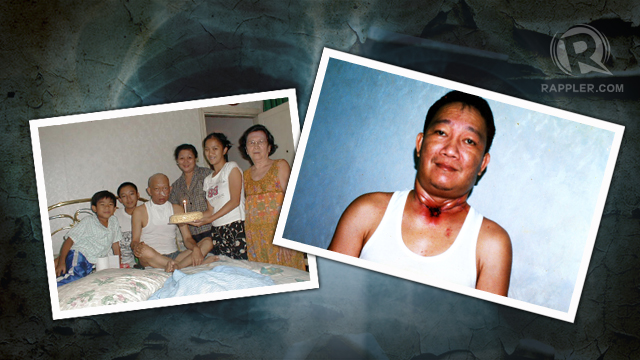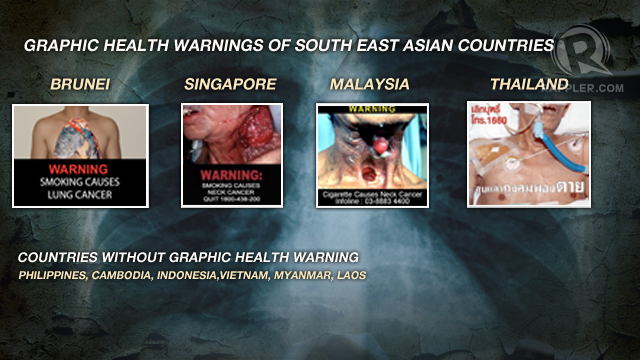SUMMARY
This is AI generated summarization, which may have errors. For context, always refer to the full article.

MANILA, Philippines – Emer Rojas, 54, was once a smooth talking radio announcer. But when I came to interview him, he was dead silent. Without a word, he carefully placed two fresh batteries in a small black electrolarynx, pressed the device to where his vocal chords were cut, and buzzed to life.
“People call me the walking graphic health warning,” he said in a robotic voice.
In 2002, after 27 years of chain-smoking, Rojas was diagnosed with stage 4 laryngeal cancer.
He lost his voice box. In chemotherapy, his firm 160-pound frame was reduced to a skeletal 90 pounds.
He may be the closest thing the Philippines has to a warning that shows the gruesome effects of smoking.

It has been almost a decade since the Philippines agreed to enforce stricter tobacco control policies by signing the Framework Convention on Tobacco Control (FCTC). But the country is still on square one when it comes to picture-based warnings.
More than 4 years ago, in September of 2008, the Philippines missed its deadline for instituting more effective tobacco warnings, which should cover at least 30% of the front and back of packages and may include pictures.
Because of Congress’ failure to pass House Bill 3364 (or “An Act to Effectively Instill Health Consciousness through Picture-based Warnings on Tobacco Products”) in 2008, then Health Secretary Esperanza Cabral issued an administrative order that sought to accomplish what the bill failed to do.
She issued AO 2010-0013 in May 2010. The following month, cigarette companies filed 5 cases in 5 different local courts against the AO. Fortune Tobacco and Japan Tobacco asked regional trial courts to declare the order invalid. La Suerte, Philip Morris Fortune Tobacco Corporation (PMFTC) and Mighty Corporation asked the courts to rule on the authority of the health department to issue the order.
Across the board, implementation of the order has been stalled in the regional courts. Even Mighty Corporation’s case, which was elevated to the Supreme Court En Banc, has not been resolved, despite a very urgent motion filed by the government.
Worse, Cabral was replaced by the new President in mid-2010. Her successor, Secretary Enrique Ona, has been less zealous in fighting for graphic health warnings.

According to the Canadian Cancer Society, 40% of the world’s population lives in countries or jurisdictions that have finalized requirements for picture warnings.
Of the top 6 economies in the Association of South East Asian Nations (ASEAN), 4 already have graphic health warnings (Thailand, Singapore, Malaysia, and Brunei). A 5th, Indonesia, passed a regulation, signed by the President on December 24, 2012, to adopt picture warnings in a year and a half. That means soon the Philippines will be the only one of the top 6 ASEAN economies not to require the warnings.
Implementation of the graphic health warning, which has been identified as one of the most effective ways to deter smoking, has been stalled for 3 reasons – lack of political will, a drawn-out legal battle, and legislative compromise.
Text versus graphic warnings
President Aquino, who is known to smoke in private, advocated increasing excise taxes on tobacco, but he has not supported graphic health warnings as aggressively or as publicly.
Right now, cigarette packages in the Philippines carry text warnings like “Smoking Kills” and “Cigarettes are Addictive.”
However, it has been found that these text warnings are less effective than graphic health warnings.
A study done in Malaysia, for instance, showed that text warnings became less effective over time, with only 9% of smokers induced to quit from the ads in 2005, down from 14% the year before.
During the run up to the presidential elections in 2010, Newsbreak asked Aquino about his stance on the graphic health warning. Unlike other candidates who said they would go as far as issuing an executive order to support the AO, Aquino was noncommittal. He made a broad statement saying, “In 2005, the Philippine government ratified the World Health Organization’s FCTC, in which the country committed to curb smoking though taxes and other measures to reduce tobacco demand, as well as large health warnings placed on cigarette packs.”
Studies show that both efforts—higher taxes and picture warnings—curb smoking. The government has successfully increased tobacco prices. But when it comes to effective warnings, the Philippine government has been weighed and found wanting.
According to the World Bank, a 10% hike in cigarette prices equates to 8% drop in smoking. That could prevent 9 million deaths in lower-income countries.
But surveys show adequate warnings also discourage smoking. An August 2012 Social Weather Stations survey of 1,200 teenagers found that among those who smoked the majority, or 64%, would smoke less if cigarette packages showed graphic health warnings, while 34% said they would quit outright. Only 3% said they would keep smoking at the same frequency after seeing the graphic warnings.
Still under its current secretary, the health department has focused more on tax reform than health warnings.
Under Ona’s leadership, the DOH even formed an unconventional partnership with Ilocos Sur Gov Luis “Chavit” Singson, who was once charged with diverting P30 million in tobacco excise taxes.
At the press conference announcing the alliance, Rappler asked about the DOH’s support for pictorial warnings. Ona made his shortest statement of the event and failed to explicitly mention graphic health warnings. “We support the Framework Convention on cigarettes and I think this bill (for reforming sin taxes) is a major step to support that,” he said.
After the press conference, Singson who is from the tobacco-growing province of Ilocos Sur, explained that he had warned Ona not to speak about the graphic health warning.
“I told the Secretary if he starts talking about that, I want to shut my ears,” said Singson. “He might tell everybody that it’s bad. I can also say don’t listen to him because we are in the tobacco industry,” he added.
Another health officials said the government is focused on other health issues.
Asked about reducing smoking through graphic warnings, Dr. Eric Tayag, Director of the Department of Health’s National Epidemiology Center, said, “There are other public health threats and there are other priorities for this administration. And we are actually bank rolling Universal Health Care – that means improving access to services. So it’s first thing’s first.”
Activists like Bayan Muna Rep Teodoro Casiño have charged the administration with being more concerned with collecting revenues than reducing smoking. Casiño even argued against sin taxes, saying that once the government began collecting more from tobacco they would not try to “reduce tobacco and alcohol intake because that will mean lower revenues.” He asked government to lead a more “aggressive” health campaign against smoking. Casiño called on the president to lead by example and quit.
Philippine Medical Association President Dr. Oscar D. Tinio said, “If we are able to successfully convince our people to stop cigarette smoking… then the sin taxes drastically can be reduced and eventually we will have nothing to use for Universal Health Care. So it’s a dead end.”
Forum shopping
Graphic health warnings face an uphill battle not just in the political arena but also in the courts. AO 2010-0013 sanctioning picture-based warnings was challenged in 5 different courts by 5 different tobacco companies.
“The cases involving the DOH’s Order on graphic health warnings have been languishing in the courts since June 2010. For years, tobacco companies have refused to show the truth on cigarette packs,” said Evita Ricafort, a lawyer with Health Justice Philippines, a non-governmental group that offers legal aid to the Office of the Solicitor General.
Alex Padilla, the former undersecretary of health who once spearheaded the government’s battle against tobacco, has suggested that the multiple cases constitute forum shopping, where cases of similar nature are filed in different courts.
The idea is to scout out a sympathetic court that will likely issue a favorable judgment.
For instance, PMFTC filed its opposition to the Cabral’s administrative order at a regional trial court in Batangas, where its commercial production factory is located. The case was raffled off to Judge Arcadio I. Manigbas.
In September 2010, Judge Manigbas dismissed PMFTC’s case, precisely citing the argument on forum shopping. In a concise 3-page order, he wrote: “Two incompatible decisions will wreak havoc on our judicial system. This is the very great evil which the rule against forum shopping sought to avoid.”
It would not take long before he would make a volte-face ruling.
Two months after making a favorable decision for the DOH, Manigbas reversed himself, finding that Fortune and Philip Morris Fortune Tobacco Company have no similarity of interest.
Resorting to a technicality, the judge agreed with the arguments of the tobacco firms that Fortune is more focused on selling to the small and medium priced segments, while PMFTC focuses on the premium price segment.
In February 2012, he declared Cabral’s AO invalid.
Suspicious footnotes
Manigbas’ first 3-page order had no footnotes. Curiously, his 25-page decision favoring PMFTC carried copious footnotes in a similar style to those contained in the motions and petitions filed by the respondent and the petitioner.
Government lawyers downplayed any sign of foul play.
Senior State Solicitor Maria Hazel Acantilado observed that it is not uncommon for a judge to ask both parties to draft a sample decision. The only caveat is that both parties must agree to it.
“It’s less work for the one deciding,” explained Acantilado.
Associate Solicitor Karen M. Malabanan, who was also helping with the tobacco cases, said that in the case of Manigbas’s ruling, the respective parties were not asked to submit a draft. “There is the presumption that the judge ruled in accordance with the law and did his own research.”
PMFTC’s attorney Louie T. Ogsimer declined to comment on a pending case.
But Rappler’s further inquiry raises additional questions.
Prompted by the difference in form and substance between the judge’s initial ruling and final ruling, Rappler inspected 7 past cases decided by Manigbas. While the 7 cases inspected differed in length, not one had footnotes, unlike his ruling on the tobacco case.
Court workers we interviewed say Manigbas is not computer savvy, and prefers in-text citations, even on a 30-page case.
A public attorney with cases in Judge Manigbas’ court, Rea L. Morcilla-Olap echoed the judge’s penchant for in-text citations. “When he cites references he cites the references in the body instead of the footnotes. He always cites references, but not in the footnotes.”
Olap however added that “sometimes a judge can adopt the style of the lawyer. If the lawyer cites by footnotes, he can also adopt the footnoting style.” Olap said Manigbas is known to have a “clean record.”
Judge Manigbas refused to be interviewed for this story.
In any event, other regional trial courts (RTCs) have separately issued unfavorable rulings against AO 2010-0013. An official case update released to Rappler on Feb 18, 2013 by the DOH showed that tobacco companies had been outright victorious or that cases had been stalled, helping them avoid compliance with the order:
- Telengtan Brothers & Sons Inc (doing business under the name & style La Suerte Cigar & Cigarette Factory) vs. DOH, Civil Case No. 10-0277 – The regional court declared the order mandating picture warnings invalid. Court documents show the case is now pending in the Court of Appeals.
- PMFTC Inc vs. DOH, SP. Civil Case, No.10-06-5232 – The Tanauan court declared the order void and stood by its decision, rejecting the government’s motion for reconsideration. The government filed an appeal with the Supreme Court via a petition for certiorari but the case is still pending.
- Fortune Tobacco Corp vs. DOH, SCA No. 2010-796-MK – The regional court granted Fortune a preliminary injunction. Since that decision the case has been deferred to the Supreme Court, where it is still awaiting review.
- JT Int’l (Philippines) Inc vs. DOH, Civil Case No. 72567- The Department of Health did not release an update on the case with Japan Tobacco Internationally Philippines. Representatives of Health Justice said the case is still ongoing in the regional trial court.
- 5. Mighty Corp vs. DOH, Civil Case No. 393-M-2010 or Supreme Court Case (G.R. No. 193414) – Although the regional court granted Mighty’s preliminary injunction, the government referred the case to the Supreme Court En Banc, where the constitutionality of the order should be determined. The case is still pending.
Read the full DOH brief below:
Out of desperation
As the Tanauan judge wrote, the Tobacco Regulation Act specifically “preempts further regulation of labeling on tobacco products” since it says “no other printed warnings [except the government health warning and the prohibition notice on sale to minors] shall be placed on cigarette packages.”
Former health undersecretary Padilla pointed out that the timing of the law’s passage was suspect. The bill was rammed through the House and Senate and signed by the President in June 2003, just 3 months before she signed the much more restrictive Framework Convention on Tobacco Control (FCTC).
In a previous story by Newsbreak, an industry source was quoted as saying that lawyers for a major cigarette company drafted the law based on compromises that they reached with lawmakers.
Before the bill was passed Padilla warned in a speech, “It is deceptive because in the guise of controlling tobacco and pursuing the interests of a healthy lifestyle and environment, this piece of legislation was actually intended to subvert the coming implementation of a more comprehensive tobacco control effort by the Department of Health.”
An insider in the Solicitor General’s Office at the time said that they, along with NGOs, accepted the bill out of desperation just to have a tobacco control-law after years of fighting. The law creates an Inter-Agency Committee on Tobacco (IAC-T) to oversee implementation of tobacco control laws.
But a representative of the tobacco industry is allowed to sit on the committee that is meant to regulate it. Their presence at meetings is counter to the interests of the public and health, according to Dr. Maricar Limpin the executive director of the Framework Convention on Tobacco Control Alliance Philippines and the NGO representative on the committee.
The chair of the IAC-T, Department of Trade and Industry Undersecretary Zenaida Maglaya said the presence of two opposing camps at the committee has hindered any productive discussions, “Because you have civil society and you have industry, never have I ever had a meeting where there is no disagreement. If (I do) I’m surprised they were so peaceful and we finished the meeting.”
Maglaya says that the committee’s mandate is not to create new regulations but to enforce existing ones. “If you want to compel the tobacco industry or the manufacturers you have to put that in the law,” she said.
“There may be a need to amend the law and we would not like to close our minds to the possibility of amendments to the law. Because as we implement it, we see that there are some grey areas and still room to really improve on it,” she added.
The march towards picture based warnings has ground to a halt in the courts and implementing agencies.
The only prospects for moving forward are new legislation or an executive order from the President. With political support for both avenues unlikely, picture based warnings remain an elusive dream for anti-tobacco advocates. – Rappler.com
Related stories:
Add a comment
How does this make you feel?


There are no comments yet. Add your comment to start the conversation.